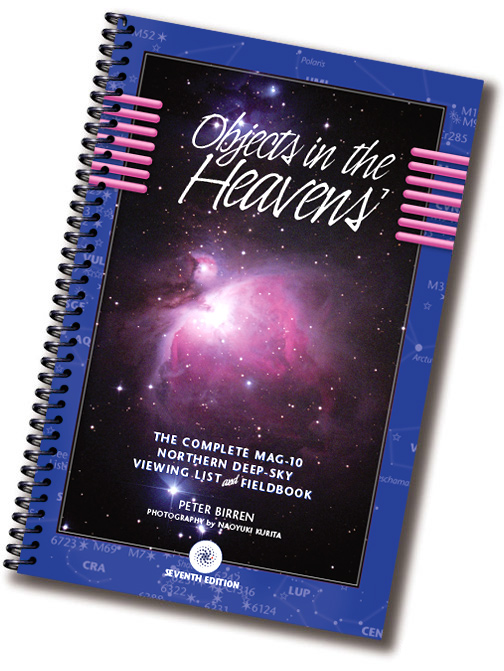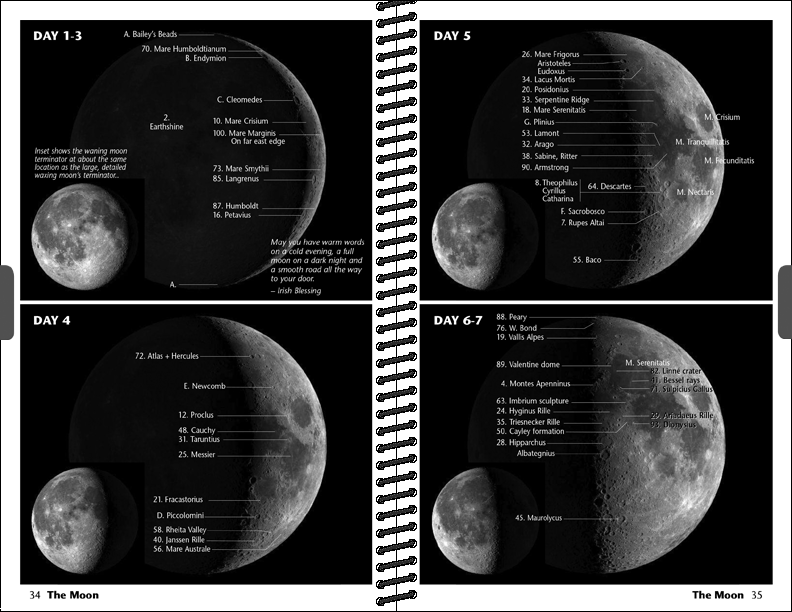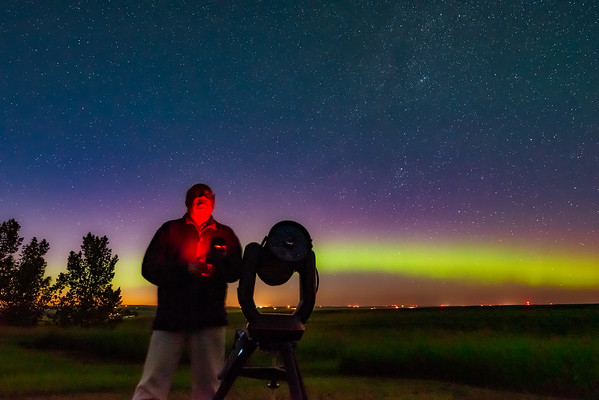



Objects in the Heavens: A Pocket Guide to the Deep Sky
By: Alan Dyer
Published: Jan 07, 2023
Every observer needs a good star atlas. But charts alone aren’t of much value in helping you decide what objects of the thousands plotted are worth looking at. Objects in the Heavens provides that essential guide.
Self-published by author Peter Birren, this pocket-sized spiral-bound book provides a constellation-by-constellation listing of all the best targets for each area of sky, along with a small finder chart.
The limiting magnitude is about 10.5, so this is not a guide for those with large aperture telescopes wanting to go after every faint fuzzy in the field. Even so, the compilation totals 750 objects, enough for many years of viewing pleasure.
The book includes some 240 targets not in either the Messier or NGC catalogs,
including 30 unique asterisms. (All photos: Alan Dyer)
What I particularly like is that, in addition to the usual Messier and brightest NGC objects, the book directs you to a host of lesser-known but still interesting targets from more obscure listings, such as star clusters from the catalogs of Collinder, Ruprecht, Trumpler and others.
In addition, the listings include asterisms, arrangements of stars that might not be officially recognized as clusters but are nevertheless fun to look at.
Stars are not forgotten. The best double stars, red giant and carbon stars, and other colorful single stars are included. This means the book works well for suburban observers, too.
The only class of objects I’d like to see better represented is dark nebulas. Only two Barnard objects are included, along with the dark regions of the Funnel Cloud and Northern Coal Sack nebulas in Cygnus.
Seasonal maps help orient the observer and mark the locations of the
brightest objects included in the detailed constellation charts.
The book covers the sky only down to 45° South declination, so rich southern constellations such as Carina and Crux are not included, nor are the Magellanic Clouds. As they often do, southern hemisphere users have to turn to other field guides.
Tables list stars first, then Messier and NGC objects, then targets from
lesser-known catalogs, with objects within each class in order by Right Ascension.
A curated list of several hundred objects is still a lot to tackle. But Birren helps you pick out the best of the best by indicating the brightest objects in boldface in the tables, and with a circle on the star charts. Objects suitable for binoculars are also marked with a symbol in the tables.
A few crowded regions, such as the Coma-Virgo galaxy field and in Sagittarius
get close-up charts.
Indeed, Birren makes extensive use of symbols and codes throughout to pack as much information as possible into the compact layout. They are all explained, and it pays to learn what they all mean to get the most out of the book. For example, a gray bar beside a group of objects in the table, a graphic element easily missed, indicates that those objects are all close to each other in the sky, perhaps within the same field of view.
Tables of various catalogs make it easy to locate the page and chart that
describes and plots the object.
Tables in the preamble material list double stars and red stars by constellation. Other tables list all the Messier and NGC objects in numerical order, along with the constellations where they can be found, making it easy to locate an object of interest. The same is true of all the non-NGC targets the book includes, with a separate listing of the 240 or so named objects included. Birren has done a good job collating many of the odd nicknames now in use.
With the current 2022 edition, the book is printed on coated paper that should stand up to use in the field on damp nights. The spiral binding allows the book to lie flat or be flipped open to just the chart page for use at the finder scope.
Objects in the Heavens serves as a fine complement to the original
Pocket Star Atlas, matching it in size and binding.
The book’s small maps might be sufficient to serve as finder charts for aiming telescopes, especially if they are equipped with red-dot or Telrad-style finders. However, most users will find Objects in the Heavens a great complement to Sky & Telescope’s excellent Pocket Star Atlas, and both will nicely pack into an accessory box. In fact, each chart in Objects in the Heavens references the Pocket Star Atlas chart that contains that constellation.
The small Moon maps label the top “Lunar 100” features by phase, but
can serve only as an introduction to lunar exploration.
While the book does include illustrations of the Moon for each phase, these thumbnail photos and the labels for the top 100 lunar features are too small to be of practical use. They would need to occupy a full page each to be usable as a basic Moon atlas at the eyepiece.
(The Moon photos have been completely redone for OITHv6.5 as shown below)
However, Objects in the Heavens stands out as a well-curated guide to the best of the deep sky. It has to be ordered from the author’s website, which can be hard to find. Search for “Objects in the Heavens” and you might be taken to Amazon pages offering used copies of older editions at exorbitant prices. Avoid those; buy new and direct!
Objects in the Heavens (Edition 7.0, August 2022) By Peter Birren (v7.0 available April 2025)
Plus
Excellent curated lists of objects
Many less well-known objects included
Compact, spiral-bound format
Minus
Moon charts not of practical use
Hard to find on the web
For northern hemisphere only
MSRP: $24.95 plus shipping; $6.50 for PDF eBook
Website: https://birrendesign.com/astro.html
About Alan Dyer:

http://www.amazingsky.com
Alan Dyer is an astrophotographer and astronomy author based in Alberta, Canada. His website at www.amazingsky.com has galleries of his images, plus links to his product review blog posts, video tutorials, and ebooks on astrophotography.